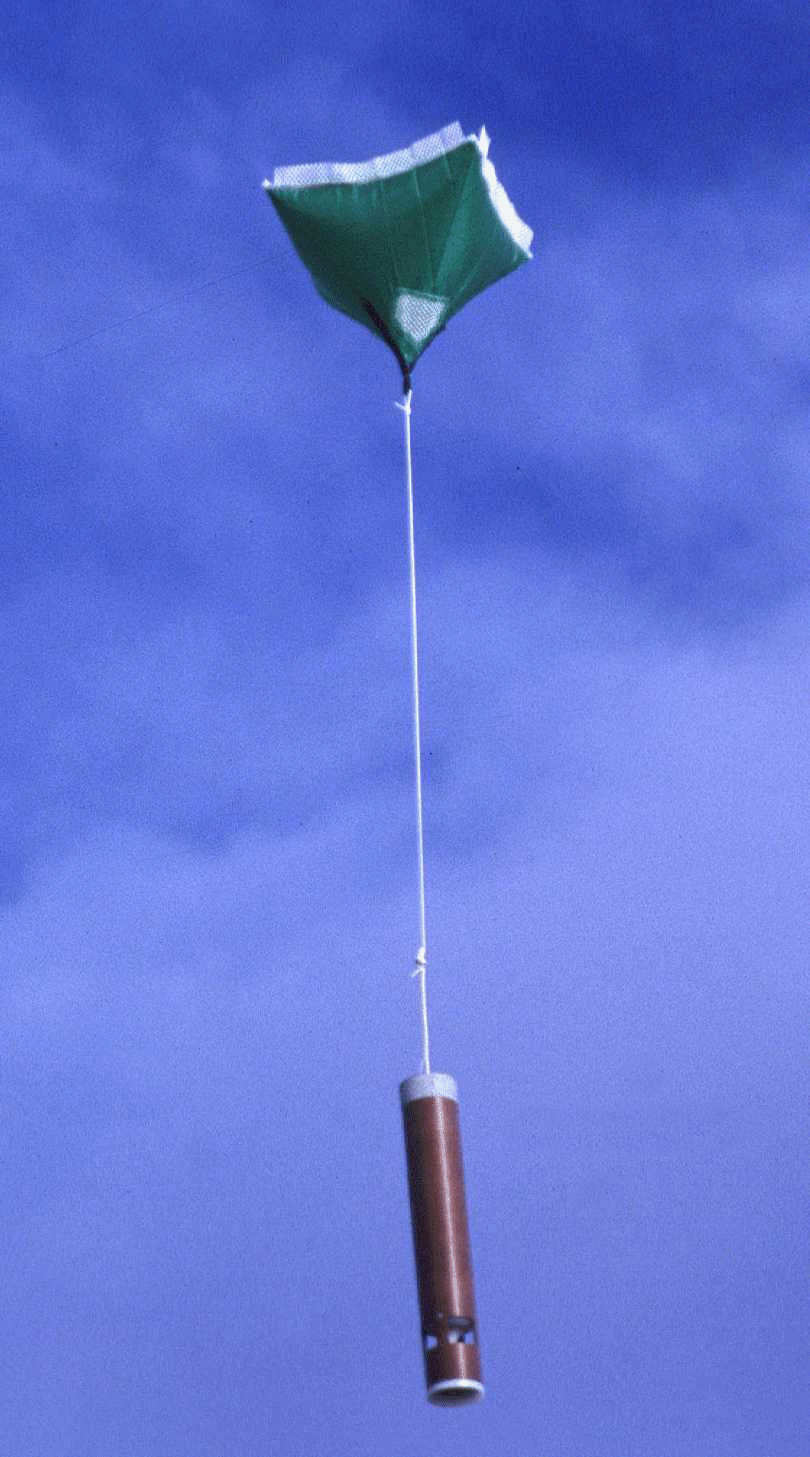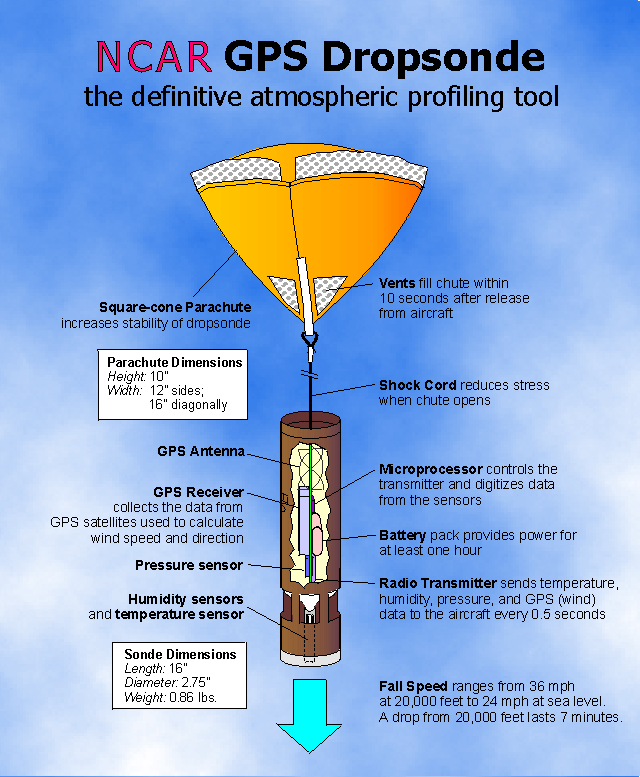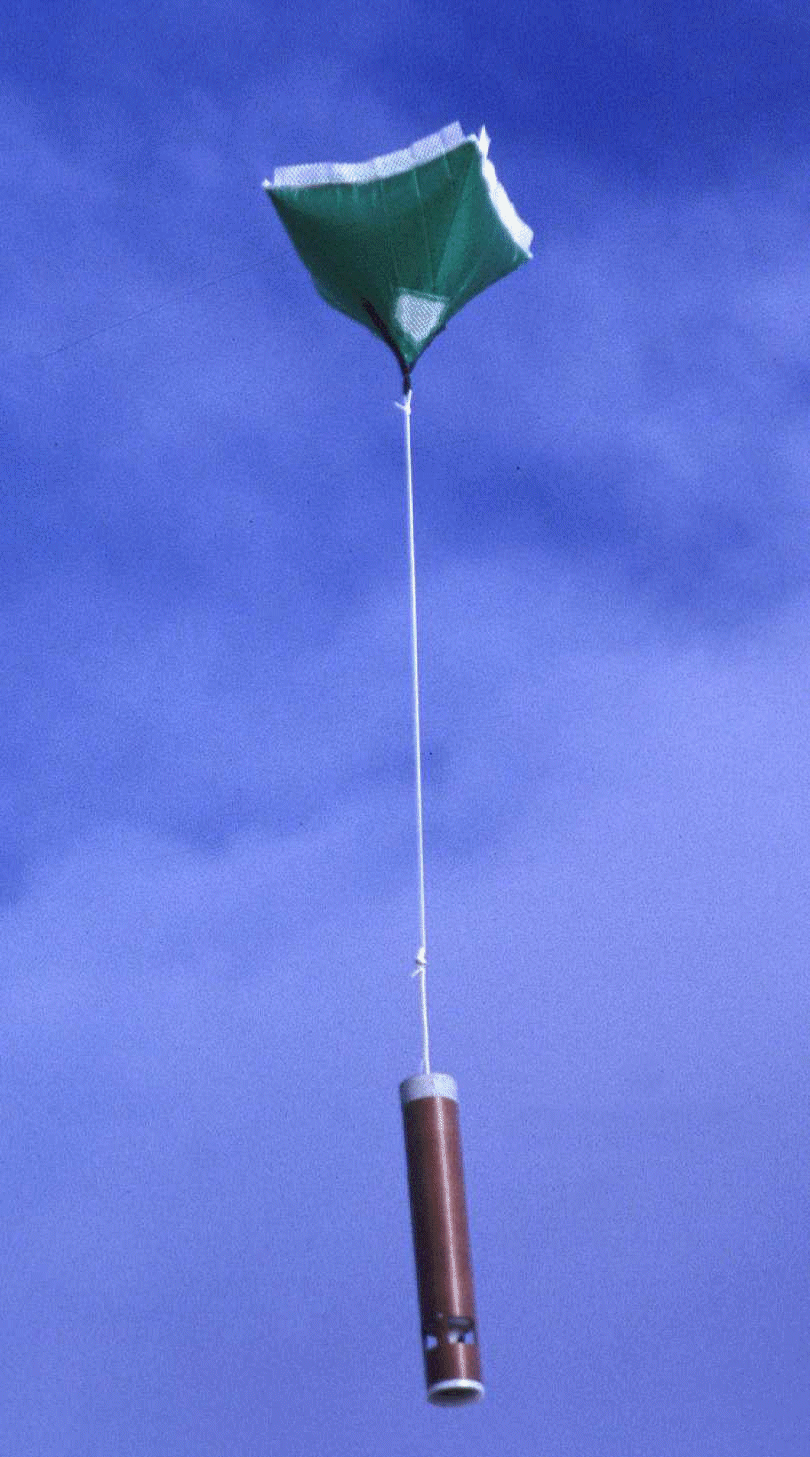GPS Dropsonde
 A dropsonde is a weather device that is designed to be dropped out of an aircraft at specified altitudes and due to the force of gravity, drop to the Earth. During the descent the GPS dropsonde collects data of the surrounding atmosphere that is remotely sent back to the aircraft by radio transmission.
A dropsonde is a weather device that is designed to be dropped out of an aircraft at specified altitudes and due to the force of gravity, drop to the Earth. During the descent the GPS dropsonde collects data of the surrounding atmosphere that is remotely sent back to the aircraft by radio transmission.
The GPS dropsonde contains a GPS receiver, that through analysis of the GPS latitude and longitude points, wind speed and wind direction can be detected. The dropsonde also contains pressure, temperature and humidity sensors that capture vertical profiles of atmospheric thermodynamic data. The descent of the dropsonde is slowed by a small parachute, that also ensures that the device will stay vertically oriented during the descent to the ocean. Dropsondes are typically released about 42,000 ft above the ocean surface.
Dropsondes play a very important role in the data collection during field projects. Along with measurements taken by other instruments aboard the research aircraft, they provide data of a near-vertical profile of very remote regions that could otherwise not be be studied in this manner. The dropsonde provides actual readings of the atmosphere as it travels downward because the device is in contact with the medium that it is measuring, this type of sensing is also called in-situ sensing. A thermometer is the most common in-situ sensing device.
Roughly 30 dropsondes are released during a typical research flight, with each flight lasting about than 8.5 hours - that's about one dropsonde every 15 minutes.
Dropsondes are essential to data collection methods because it can be very difficult to collect in-situ data, particularly vertical profile data, during severe weather. Research aircraft are able to fly in safe-zones around and above severe weather and collect other types of data, but the dropsonde system provides critical in-situ data that could not otherwise be collected.
Anatomy of a Dropsonde
 Square-cone parachute: Attaches above the device increases the stability, as well as slows the free-fall a bit for more accurate readings.
Square-cone parachute: Attaches above the device increases the stability, as well as slows the free-fall a bit for more accurate readings.
- Height-10"
- Width-12" sides, 16" diagonally
- GPS Receiver: Collects data from the GPS satellites which is then used to calculate the wind speed and direction. If latitude and longitude are known, then wind speed and wind direction can be calculated as well.
- Pressure Sensors: Sense the atmospheric pressure at each location of the descent
- Humidity Sensors: Senses the humidity at each location during the descent
- Temperature Sensors: Senses the temperature at each location of the descent
- Microprocessor: Controls the transmitter and digitizes data from the sensors
- Battery Pack: Provides power for up to one hour
- Radio Transmitter: Sends temperature, humidity, and pressure back to the aircraft every 0.5 seconds; wind speed and direction every 0.25 seconds
- Fall Speed: from 40,000 feet ~28 m/s and 11.5 m/s at sea level; a drop from 20,000 ft lasts 7 minutes
- Sonde Dimensions
- Length: 16 in/40 cm
- Diameter: 2.75 in/5.8 cm
- Weight: 0.86 lbs/350 g
- Mini-Sonde Dimensions
- Length: 12 in/30.5 cm
- Diameter: 1.75 in/4.5 cm
- Weight: 0.36 lbs/165 g
Let's do a little math here....
It takes each dropsonde that is released from approximately 42,000 feet, about 18-20 minutes to fall to the surface below. Let's call it 20 minutes to make our math easier.
20 minutes = 1,200 seconds
Pressure, temperature and humidity data is transmitted every 0.5 second or 2/second: 3 data points x 2/sec x 1,200 seconds = 7,200 data points
Wind speed and wind direction data is transmitted every 0.25 second or 4/second: 2 data points x 4/sec x 1,200 seconds = 9,600 data points
7,200 data points + 9,600 data points = 16,800 data points per dropsonde
~30 dropsondes per flight
16,800 data points x 30 dropsondes = 504,000 data points per flight!
That's a lot of data!
NSF/NCAR HIAPER :: Dropsonde Launch
Read more about the NCAR GPS Dropsonde

